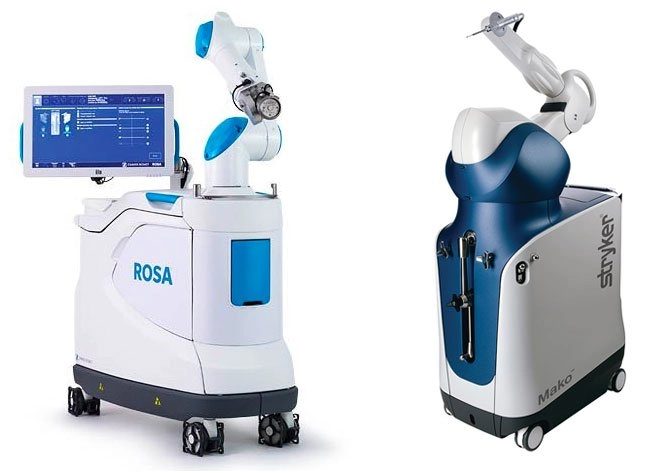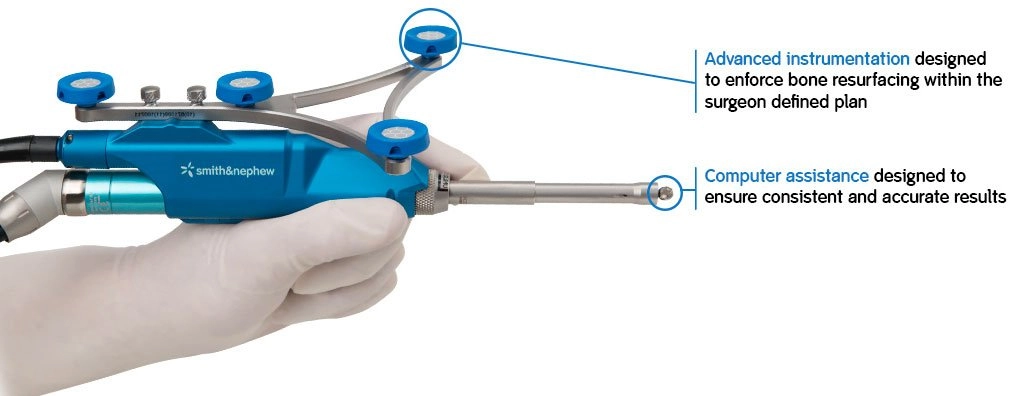
The ROSA™ and MAKO™ are two types of robots used in robotic knee surgery.
What is robotic knee surgery?
As is the case in many industries, robotics and computer-based technologies are being used to improve the accuracy and efficiency within orthopaedic surgery. Robotic-assisted knee replacement involves the use of a robotic arm, which is controlled by the surgeon to assist in planning and placement of the knee replacement components. Its use is becoming more widespread in facilities both in Australia and Internationally. I offer robotic knee surgery (partial and total knee replacement) at Hollywood Private Hospital.
What happens in robotic knee surgery?
Prior to your surgery your anatomy, defined by pre-operative X-rays or CT scans, is matched to a computer-generated 3D model. This allows me to ‘plan’ your knee replacement pre-operatively, effectively giving me a useful guide as to how your knee replacement can be placed to optimise your post-operative function and results.
Robotic knee surgery is not automated – as your surgeon, I am still performing all tasks such as making the skin incision, exposing the knee joint, cutting the bones, placing the implants and closing the incisions at the completion of the case. Rather, the ‘robotic’ element of the surgery is to guide the cutting of the bones to help optimise positioning and accuracy of the placement of the knee prosthesis.
What kind of implants are used in robotic knee surgery?
The implants (prostheses) that are inserted into your knee during robotic knee surgery are the same as those used in more traditional methods of knee replacement surgery. These are not customised to individual patients, but rather there are a large number of sizes and options of implants that can be combined in many different ways to match your natural knee positioning.
What do the robots look like?
The robotic systems currently available make use of a robotic arm (ROSA™ and MAKO™) or a computer-controlled hand-held burr (NAVIO™). Both of these systems are positioned next to you and draped in sterile covers, to enable use of the robot without ‘desterilising’ the surgical field.


Is robotic knee replacement better?
Robotic-assisted knee replacement surgery is still relatively new, so there is no clear evidence to suggest it is superior to other methods of knee replacement positioning in terms of post-operative function and prosthesis survival. There is some evidence in the Australian Joint Registry to show robotic partial knee replacement surgery is performing very well, but it’s important to note this is often compared to older prostheses and methods so it’s not necessarily a fair comparison.
In Australia, there has always been a strong uptake of new technology when concerning knee replacements in comparison to many other countries. As a result, the improvements in outcomes with the use of robotic knee replacement in other areas of the world might be more profound than the benefits that are seen here in Australia. Still, the technology is a very useful tool, and can help the surgeon in the planning and placement of the knee replacement which is ultimately a good thing.
What are the advantages of robotic knee replacement?
- Increased accuracy of placement of the prosthesis when compared to traditional, ‘instrumented’ knee replacements
- Reduction in error and ‘outliers’
- Accurate pre-operative planning
- Accurate bone cuts when compared to traditional knee replacements
- Ability to alter or ‘recut’ with accuracy intra-operatively
What are the disadvantages of robotic knee replacement?
- Cost: each robot costs upwards of $1million, which is currently borne by the hospital
- Increased pre-operative investigations: depending on the system being used, some robotic knee replacements require more pre-operative imaging than traditional methods, increasing cost and exposure to radiation through imaging
- New technology: whilst early results of robotic knee replacement are very pleasing, any new technology introduced to surgical methods need to be studied and appropriate training undertaken before being used in the clinical setting
All surgery, including robotic surgery, involves risks. To discuss your options for robotic knee replacement surgery or for any further information please contact me to arrange a consultation.



